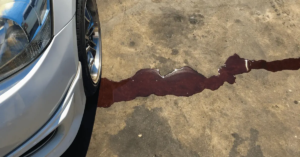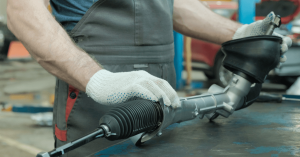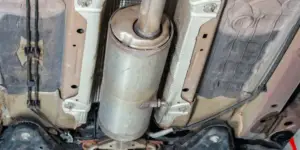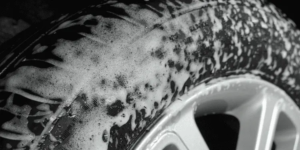
Have you noticed a strange leak coming from your vehicle? A car leak issue can throw a wrench into your plans. If you’ve noticed light, reddish brown, or amber fluid leaking from the tie rod boot area, chances are there’s a problem with your pinion or steering rack. So, what are the causes of power steering fluid leaking from the tie rod boot and what should you do?
The top 3 causes behind power steering fluid leaking from the tie rod boot area are broken rack seals, a worn-out pinion, or a steering rack that’s no longer functioning properly. While it’s possible to fix a power steering leak located near the tie rod boot, replacing the pinion-and-steering rack system can be a complex process. For this you should consult a qualified mechanic.
Once you’ve identified the cause of the leak, the next step is to fix it. In this article, we will cover in depth each possible cause and how to solve it. Read on to learn more about the causes for power steering fluid leaking from the tie rod boot and what the solutions are.
What You’ll Need
- Jack stands
- Flare nut wrench
- Open-end wrench
- Tape measure
- Power steering fluid with sealer
- Replacement steering rack seal
- Replacement pinion
- Replacement steering rack
Power Steering Fluid Leaking from Tie Rod Boot: 3 Causes and Solutions
1. Broken Rack Seals
The good news is that the most common reason that you might notice power steering fluid leaking around the tie rod boot area is from a faulty or broken steering rack seal.
A tie rod boot doesn’t contain any liquid and acts like a dust cover for your tie rod area, so even a broken boot won’t cause your power steering fluid to leak. Even if you replace a cracked boot, this will only mean that you now have a new boot filled with power steering fluid.
That’s why you’ll want to locate the source of the issue so that you can fix the problem.
In most cases, leaking power steering fluid in this location means that a steering rack seal or gasket has perished. This is a common issue if you have an older vehicle or haven’t driven it in a while.
If you’re looking for a temporary fix, you can use OIL-FIX to stop a power steering leak in its tracks. If you identify a leaky seal as the culprit, you should replace it immediately to avoid any future issues.
2. Cracked Hose or Line
A second reason for a tie rod boot that’s leaking power steering fluid is down to a faulty connection or a cracked hose or line in the power steering pump. These hoses can dry out, shrink, loosen, or crack over time. Excess pressure in the system due to an overfilled reservoir can crack the seals or hoses and cause leakage to occur.
If you suspect that this is the issue, check the flexible lines between the steering column and rack and pinion area.
When you identify a leak, depending on the location of the leak, the first thing to do is to shut off the car. That’s because power steering fluid leaking into or near a hot engine can catch on fire.
It’s possible to replace a bad power steering fluid hose yourself if you’re handy with cars. If you haven’t replaced this hose before, it’s a good idea to take a photo of your hose in situ before you remove it, so you know its exact orientation.
How to Replace the Power Steering Hose
- First put a drain pan under the pump’s pressure hose connection. This is located at the gearbox or steering rack. The pan will catch any gushing fluid as you work.
2. Next, use a flare nut wrench to undo and remove the fittings that hold the pressure hose in place in the steering rack and the power steering pump.
3. Buy a new power steering pressure hose and install it in the area. Make sure to route it in the same way as your previous power steering hose.
In the case that you can’t fix it yourself, reach out to a qualified mechanic to get the job done. While the exact cost may depend on whatever other components in the area are also failing, it typically costs around $500-$650 to fix a power steering fluid leak.
3. Failing Steering Rack and Pinion

The final reason why you may notice power steering fluid leaking down from the tie rod boot is due to a failing rack-and-pinion system. The good news is that this is a rare cause for leaking fluid and most cars run for their entire lives without needing a replacement steering system.
The pinion refers to a small gear in a car’s drive train. This vital gear drives a bigger gear that enables the steering wheel to turn.
Just like the pinion, the steering rack is part of your vehicle’s pinion-and-rack system located near the front axle. It enables your car to turn left or right when you move the steering wheel.
If your steering wheel has a lot of play in it, it may be time to replace the entire rack system to fix the steering fluid leak problem and avoid any safety issues with a deteriorating steering rack in the future.
While you can buy a power steering product that contains sealant, this is usually only a temporary fix. In fact, this kind of sealing product will only plug a small leak for a day or two. Some mechanics might use plastic zip ties or a metal clamp to keep the problem in check temporarily. Unfortunately, this can cause the boot to split and leak more fluid.
Before long, you’ll notice that annoying leak again. If you plan to keep your vehicle for the foreseeable future, then it is probably wise to replace the rack. Usually, this means replacing the entire pinion-and-rack system since most mechanics don’t fix or rebuild each one separately.
Rebuilding the Steering Rack System
If you have the time and know your way around a car, it’s possible to rebuild a steering rack system. It’s not possible to rebuild the steering rack system in situ, so you’ll need to pull it to rebuild it. While replacing the system itself isn’t difficult, 90% of the work comes from trying to get the system out and then back in. This can seem like an infuriating process, but once you find out how to strip down the system and get it out and back in, the rest is easier.
If you’re not up for this, the best course of action is to take your car to a reputable mechanic. Keep in mind that getting a mechanic to replace a steering rack can make a sizable dent in your wallet. Additionally, it may cost as much as your car is worth. Putting a new rack in yourself may cost less than getting a mechanic to do it.
If you’re unsure if the seal, pinion, or rack is causing the issue, it’s always best to get the issue checked out to get the right diagnosis. In most cases, the seals will leak before the rack goes.
The Bottom Line
The first thing to do if you notice power steering fluid dripping from the tie rod boot is to identify the issue. This will help determine the best solution and prevent a potentially dangerous loss of power steering ability.
If your steering wheel is loose or requires effort to turn, this is likely a pinion and rack system issue. In most cases, if you’re experienced with mechanics, you can pull and rebuild the rack. While this takes a lot of work, it can also save you a ton of money. The good news is that the rack system almost never goes on most cars.
The two most common causes of power steering fluid leaks are leaking seals or gaskets or the connections around fluid hoses and lines. These items are both easier and less expensive to replace than the rack and pinion system. Therefore, checking these areas for leakage should be at the top of your list.
Frequently Asked Questions
Can Power Steering Fluid Leak from the Rack and Pinion?
Over time, a car’s rack and pinion steering system can wear out due to frequent turns and normal driving. This can create loose fittings, broken seals, or cracked hose lines.
If the power steering reservoir is too full and your car has a leaky gasket or hose, the fluid may leak and cause steering issues.
What Happens if You Drive with a Leaking Rack and Pinion System?
If the leak has just started, you’ll notice that your steering will become inconsistent. This will make it more challenging to drive. Eventually, if the issue is not resolved, your vehicle will lose its power steering assistance.
When this occurs, you won’t be able to control the steering wheel. If this occurs on a straight road or highway, this won’t be too much of a problem. If it occurs on a curved road, however, it can put you in serious danger.













